Aloe Vera for Age Spots: Natural Skincare Guide
Does Aloe vera fade age spots? Aloe vera, especially a component in it called aloesin, has shown promise in lightening age spots.
Aloesin is a depigmenting agent, believed to have skin-lightening properties. It can potentially help in breaking down melanin, the pigment responsible for dark spots on the skin, including age spots.
Research suggests that aloesin can effectively reduce melanin formation by targeting a specific enzyme in our skin, offering a natural approach to managing age spots.
In simpler terms, aloe vera might help in fading age spots. Here’s another study confirming this.
For years, I’ve been making my own Aloe vera gel directly from my Aloe vera plants (Aloe Barbadensis) and applying it to my skin.
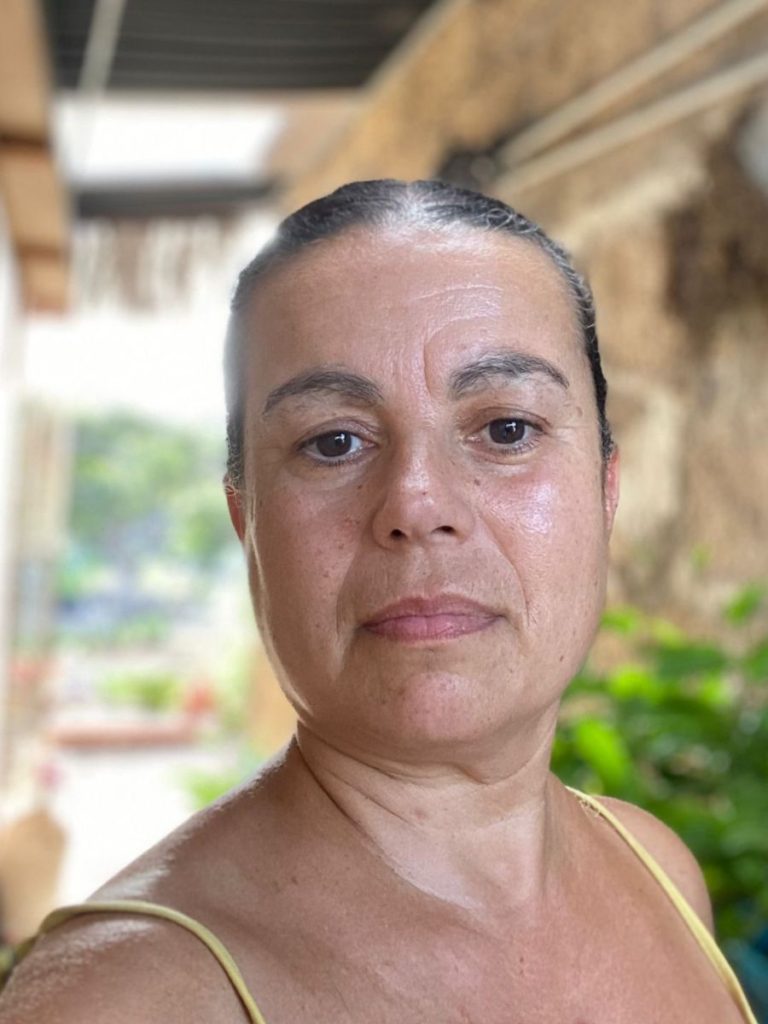
This natural remedy has worked wonders for me in the Canary Islands, where the sun is always intense and getting dark patches on the face is the norm.
My once-present melasma has entirely faded away. Unbelievable (and unexpected!).
(Melasma, like age spots, is a form of hyperpigmentation caused by an overproduction of melanin in the skin. I had quite a bit here and there, nothing too serious, but enough for some people to make a comment every now and then).
While I rely solely on natural skincare, with aloe being the foundation of my products, it’s hard to pinpoint if the flawless skin I seem to have nowadays is due to the blend of natural oils and ingredients or the aloe vera itself… or both.

However, I believe that aloe vera has been key to keeping my skin looking fresh and glowing (and without age spots!). There’s so much about Aloe vera that it’s hard to pinpoint just one benefit, but its natural wonders continue to amaze and rejuvenate my skin daily.
Here’s a little more on aloesin,
Will Aloe vera work on your age spots?
I think so. Let’s keep diving deeper.
Aloe Vera for Age Spots: Nature’s Answer to Skin Rejuvenation?
Using aloe vera for age spots (and for the skin, in general) has been an enlightening journey for many, including myself, in exploring the wonders of natural skincare.
This remarkable plant, cherished through the ages for its healing properties, showcases what nature can achieve in its purest form!
Remember, it is not about defying age but embracing it with healthy, radiant skin.
Here’s what Aloe vera has to offer:
- Rich in Vitamins and Antioxidants:
- Aloe vera is packed with vitamins A, C, and E, all known as antioxidants. These elements can help neutralize free radicals, contributing to skin ageing and age spot formation. Find the research here.
- Skin Lightening Properties:
- Aloin, a compound found in aloe vera, has shown potential in lightening the skin, making it an ingredient of interest for reducing the appearance of age spots. Find the research here.
- Deep Hydration:
- Aloe vera gel is a natural moisturizer, which means it hydrates the skin without making it greasy. Well-hydrated skin reflects light better, reducing the prominence of age spots. Find the research here.
- Collagen Production:
- Aloe vera promotes collagen production, vital for skin elasticity and health. Enhanced collagen may lead to smoother skin, minimizing the appearance of age spots over time. Find the research here.
- Natural Exfoliation:
- Aloe contains enzymes that can help exfoliate the skin gently, sloughing off dead skin cells and allowing newer, healthier cells to surface. Find the research here.
- Anti-Inflammatory Properties:
- The gel from the aloe plant is known for its soothing properties. While inflammation isn’t directly linked to age spots, a calmer skin environment can promote overall skin health and appearance. Find the research here.
I believe using aloe vera for age spots is about addressing the spots themselves and improving the skin’s overall health, texture, and radiance.
As with all natural remedies, patience and consistency are essential. Though I’ve sometimes seen improvements in just a week or two, the timeline can vary based on the extent of skin concerns. My clients also claim improvements within weeks, but everyone’s skin is different.
Tip: Ensure the aloe vera product used is pure and free from added chemicals that could reduce its efficacy or irritate the skin.
Crafting your own skincare, tailored to your needs and free from unnecessary additives, can truly make a world of difference, allowing nature’s essence to shine through and rejuvenate your skin 🙂
It has definitely made a difference for me.
Aloe Vera for Age Spots: An In-Depth Look
Over the years, Aloe vera (such a humble plant!) has become an integral part of my skincare routine, not just as a remedy but as a testament to nature’s profound ability to heal and rejuvenate.
I grow over 20 plants in my land, all of them over 5 years old. I love them dearly, they’ve become part of the family. That’s where I get my Aloe vera gel from, all made at home.
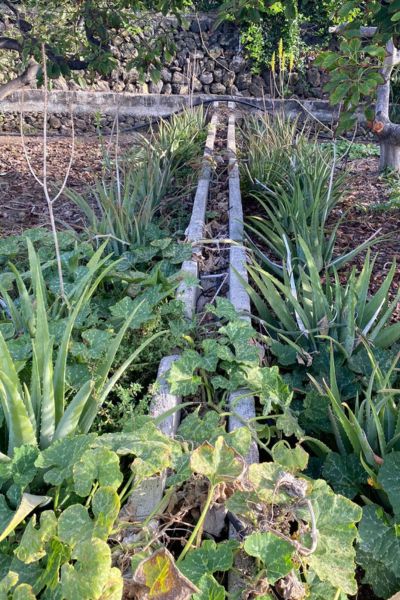
Age spots, often mistaken for mere freckles or sunspots, are a natural part of ageing.
These small, darkened patches, which can appear on our hands, face, or other sun-exposed areas, are the result of an overproduction of melanin.
While they’re a sign of many sun-soaked memories, some of us might feel the need to address them. And that’s where the magic of aloe vera comes into play.
Before we look into its benefits, it’s essential to distinguish age spots from other skin discolourations.
Unlike freckles, which are genetic and can appear at any age, or sunspots, which are temporary, age spots develop over time as a testament to our life’s journey.
What Exactly Are Age Spots?
Age spots, sometimes referred to as liver spots or solar lentigines, are small, flat, dark areas on the skin. They vary in size and usually appear on areas exposed to the sun, like the face, hands, shoulders, and arms.
These spots are very common in adults over 50 (at the time of publishing this post I’m 54), but younger people can get them too, especially if they spend a lot of time in the sun.
In fact, the sun plays a significant role in the development of age spots. Prolonged exposure to its rays accelerates the production of melanin, the pigment in the outer layer of our skin that gives it colour.
Age spots can form when melanin becomes clumped or is produced in high concentrations.
This relationship between sun exposure and age spots is supported by a study that highlights the importance of sun protection to prevent skin cancer and premature skin ageing.
As we embrace each passing year, our skin changes. It becomes thinner, loses fat, and no longer looks as plump and smooth as it once did. These are the facts.
Our skin’s ability to heal and regenerate diminishes, making it more susceptible to age spots. And, yes, it is a natural part of the ageing journey, a reflection of the many sunlit days we’ve enjoyed. I can’t complain.
While age spots are more prevalent as we grow older, they’re also a sign of how much life we’ve lived, each spot holding its own story of sunny days and outdoor adventures.
This research article provides a detailed molecular and histological characterisation of age spots, going through melanin accumulation and extensive rete ridges’ development in these hyperpigmented lesions.
The Science Behind Aloe Vera and Age Spots
But beyond its cooling and soothing properties, what does science have to say about Aloe vera’s potential in addressing age spots?
As someone who’s always been fascinated by the blend of nature and science, I’ve looked into the research to uncover the truth.
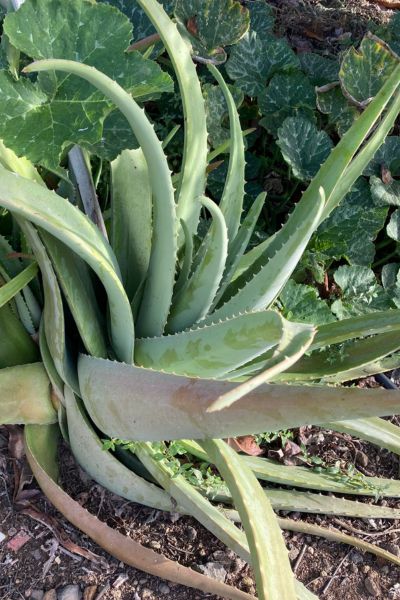
1. Aloesin: The Natural Depigmenting Agent in Aloe Vera
Aloesin, a compound found in the Aloe vera plant, is recognised for its potential as a depigmenting agent. By possibly breaking down melanin, the pigment responsible for age spots, as seen above, aloesin offers a natural approach to skin lightening.
A study titled “Enhancement of Melanogenic Inhibitory Effects of the Leaf Skin Extracts of Aloe barbadensis Miller by the Fermentation Process” highlighted the skin-lightening effects of aloesin. The research showed that aloesin effectively down-regulated the expression of genes associated with melanin synthesis, proposing an inhibitory mechanism in melanogenesis. The study also compared the efficacy of aloesin with commercial skin-lightening ingredients and found aloesin to be competitive.
In other words, aloesin manages to do the trick very nicely, without the mystery ingredients you might find in store-bought products!
Difference between ‘Aloin’ and ‘Aloesin’ in Aloe vera when it comes to the depigmentation properties:
- Aloin: This is a bitter compound found in the outer leaf of the aloe plant. It was historically used as a laxative. While it does have some skin-related properties, it’s not the primary compound associated with depigmentation.
- Aloesin: This is the compound specifically associated with skin-lightening or depigmenting properties. Aloesin is believed to inhibit the enzyme responsible for melanin production, thereby helping to reduce the appearance of dark spots on the skin.
2. Aloe Vera’s Anti-Inflammatory Properties
Aloe vera is celebrated for its anti-inflammatory effects, which can help alleviate skin inflammation, often linked to hyperpigmentation.
Skin inflammation can be a contributing factor to various skin conditions, including hyperpigmentation. By reducing inflammation, aloe vera can potentially help in preventing or reducing the severity of hyperpigmentation.
**Inflammation and hyperpigmentation are linked through a process called “post-inflammatory hyperpigmentation” (PIH) – Basically, when the skin gets inflamed, it can sometimes react by producing more pigment, leading to hyperpigmentation. This is why managing inflammation and avoiding skin trauma (like picking at pimples) is essential in preventing hyperpigmentation.
Supporting Research: The study “Antioxidant, anti-inflammatory, anti-apoptotic, and skin regenerative properties of an Aloe vera-based extract of Nerium oleander leaves (nae-8®)” delves into the anti-inflammatory attributes of an Aloe vera-based extract.
3. Antioxidant Properties of Aloe Vera
Aloe vera, abundant in antioxidants like vitamins C and E, battles free radicals that might hasten skin ageing and the emergence of age spots.
These antioxidants help neutralize free radicals in the body. Free radicals are unstable molecules that can damage cells and contribute to ageing and diseases. When it comes to the skin, free radical damage can accelerate the ageing process, leading to the formation of age spots and other signs of ageing. Aloe vera can help combat this damage by providing antioxidants, potentially slowing the appearance of age spots and other age-related skin changes.
Supporting Research: The same study on “Antioxidant, anti-inflammatory, anti-apoptotic, and skin regenerative properties of an Aloe vera-based extract of Nerium oleander leaves (nae-8®)” also accentuates the antioxidant qualities of the Aloe vera-based extract.
4. Aloe Vera’s Role in Skin Cell Regeneration
Aloe vera encourages collagen production, crucial for skin elasticity and regeneration, potentially assisting in diminishing age spots (while increased collagen can improve the overall health and appearance of the skin, the direct effect of aloe vera on age spots is more likely attributed to other compounds in the plant, like aloesin, which has depigmenting properties as seen above. Nevertheless, I thought it would be important to address skin regeneration.)
Supporting Research: The study “Fabrication and evaluation of herbal beads to slow cell ageing” touches upon Aloe vera’s role in decelerating cell ageing, which can correlate with its potential in bolstering skin cell regeneration.
Current Research on Aloe Vera and Age Spots
While there’s anecdotal evidence championing aloe vera’s effectiveness for age spots, scientific exploration continues.
A review titled “A Review of Mechanical Properties of Scaffold in Tissue Engineering: Aloe Vera Composites” examines Aloe vera’s potential in tissue engineering, offering context for understanding its impact on skin conditions like age spots.
As we’ve journeyed through the science of Aloe vera, it’s evident that this humble plant is more than just a garden ornament or a sunburn remedy. I use it for many things, and I can’t imagine my skincare routine without its natural, nurturing touch.
As we have seen, its compounds, from aloesin to its rich antioxidants, work in harmony to offer a holistic approach to skincare.
Aloesin stands out as a potential star player in reducing age spots, while the anti-inflammatory properties soothe, the antioxidants protect, and the collagen-boosting capabilities nurture. This harmonious blend of elements positions aloe vera as a potential ally in our journey towards radiant, age-spot-free, glowing, natural skin.
While individual experiences may vary, and more research is always welcomed. And, yes, it is incredibly heartening to know that nature offers such a potent solution, waiting to be embraced.
I definitely have embraced it. Let me show you below how to use Aloe vera for age spots.
Your Guide to Using Aloe Vera for Age Spots
After delving deep into the wonders of aloe vera and its standout component, aloesin, you might be eager to incorporate this natural gem into your skincare routine.
But how do you go about it?
Let’s walk through the steps to harness the full potential of aloe vera in addressing age spots.
1. Extracting Fresh Gel from Your Aloe Vera Plant
First things first, choose a mature leaf from your aloe plant – ideally one that’s 4 or 5 years old, as research suggests that this is when aloe components are at their best. Find the research here.
With a sharp knife, slice it off at the base. Then, slice off the spiky edges and remove the top edge, which probably feels flat (without gel). Look at the image below so you see what needs to be removed.
Place the leaf in water, like so, for 1-2 hours:
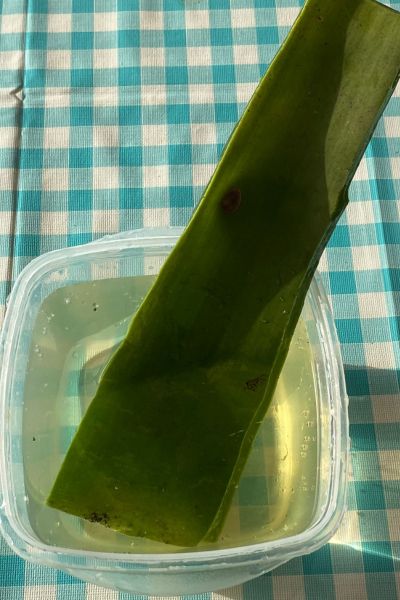
Tip: I find that placing it in water is important (as opposed to just letting it drain). This is because the aloe undergoes a process of oxidation that turns the liquid red, which can stick to the bowl’s surface, making it challenging to clean. The water helps prevent this staining; I learnt my lesson the hard way.
You’ll notice a yellowish liquid (called aloin) dripping out – it’s best to let this drain away as it can be slightly irritating to the skin (I’ve never had a problem, but we are all different, and many people are allergic to this liquid).
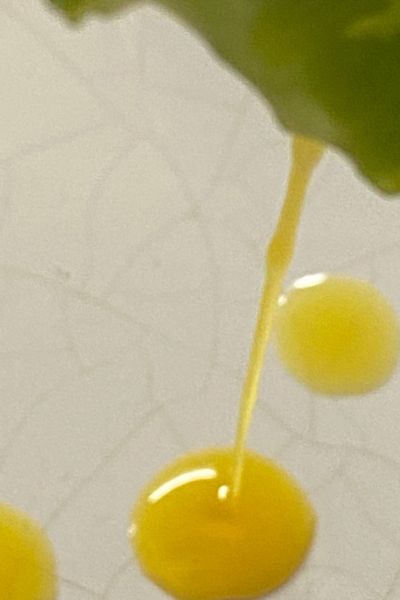
Now, lay the leaf flat and carefully slice away the outer layer of skin, revealing the clear, gel-like substance inside. Using a spoon or a spatula, gently scoop out all the gel, ensuring you get as much of it as possible without any bits of the leaf.
Once you’ve collected the gel, move on to the blending step. Blend with your kitchen blender, strain through a muslin cloth to get rid of any chunks, and there you have it – your slightly cloudy, yet pure aloe vera gel, all set to tackle those age spots.
It’s as straightforward as that. See below my DIY Aloe vera gel. I mixed it with a bit of Xantham gum, which acts as a natural thickener, giving the gel a more luxurious feel. But the blended and sieved gel will be more than good enough.
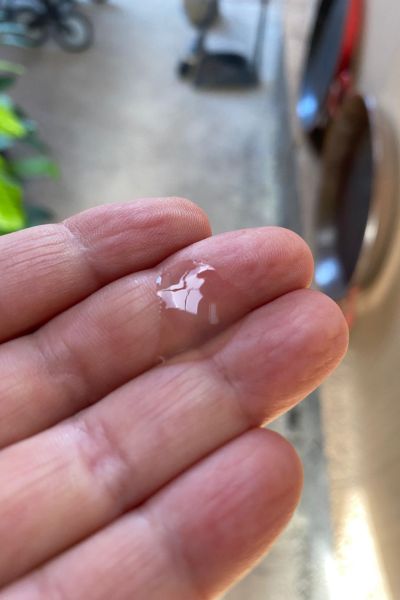
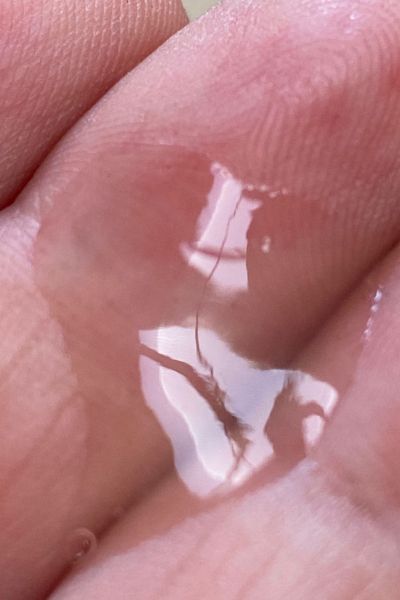
2. Applying Aloe Vera for Maximum Benefits
Gently massage the aloe vera gel into the areas with age spots. No rinsing required. See photos below so you can get an idea.
Alternatively, for an all-over skin boost, you can apply it to your entire face, neck, back of hands, and décolletage. Remember, aloe vera isn’t just for age spots; it’s packed with nutrients that can rejuvenate and hydrate your skin, giving it a radiant glow.
When you apply aloe vera to your entire face, you might notice a tight feeling as it dries. This sensation is completely normal due to aloe vera’s astringent properties, which help tighten the skin and pores.
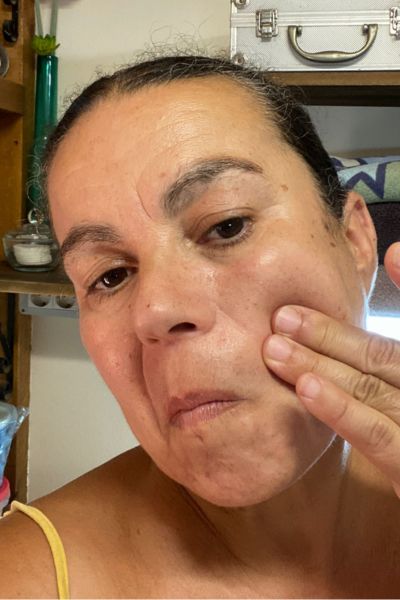
However, if you’d like to alleviate the tightness sooner, apply your regular moisturiser. Opting for a natural one is even better, of course. I make my own one.
Olive oil is a wonderful choice for those with inflamed, mature, or dry skin. Jojoba oil works wonders for most other skin types. And if you have sensitive skin, almond oil or rosehip oil can be gentle and nourishing options.
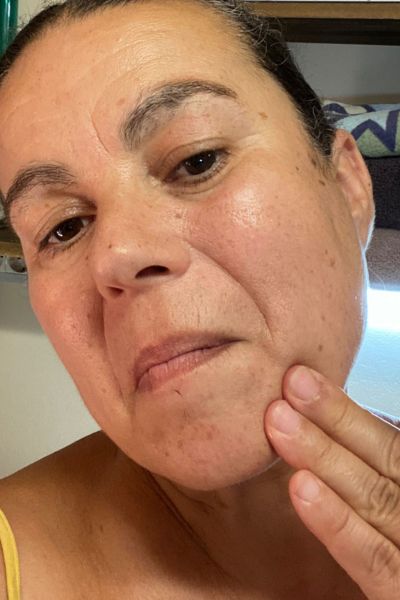
If you’re new to using such natural products and find it challenging, you can start by applying it to the age spots.
For optimal results, applying the gel twice daily for at least two months is recommended.
This consistent application will allow your skin ample time to absorb the benefits and show noticeable improvements. You may notice improvements before this time. But, please, BE CONSISTENT!!
Incorporate it into your daily skincare ritual. Let it become a nurturing habit, a moment of self-care that your skin will thank you for.
2. Storing and Freezing Aloe Vera for Future Use
You probably have extracted more aloe gel than you need for immediate use (especially if the leaves are big ones, mine are huge); please don’t let it go to waste!
You can store it for future applications, which should last a long time.
Cut the gel into small, usable portions. To prevent them from sticking together when freezing, spread the pieces out on a baking tray or plate lined with parchment paper. Once they’re frozen solid, transfer them to a freezer-safe bag or container. This way, you can easily take out a piece whenever you need it.
Frozen aloe vera preserves the gel and offers a refreshing, cooling sensation when applied to the skin.
Remember, when you take a piece out, let it thaw for a few minutes before applying.
Enhancing Aloe Vera’s Effects with Other Natural Ingredients
Aloe vera gel can be combined with other natural ingredients to boost its effects.
For instance, mixing aloe vera gel with a bit of turmeric can further its age-spot-reducing potential. Turmeric, known for its anti-inflammatory and antioxidant properties, can help lighten dark spots and improve overall skin tone.
Combined with aloe vera, it creates a potent blend that can benefit age spots. However, always do a patch test first, as turmeric can sometimes stain the skin or cause sensitivity in some individuals.
Here’s a simple guide on how to blend aloe vera and turmeric for age spots:
- Ingredients:
- Fresh aloe vera gel: 1 tablespoon
- Turmeric powder: 1/4 teaspoon
- Method:
- Combine the fresh aloe vera gel and turmeric powder in a small bowl.
- Mix well until you get a smooth paste.
- Before applying to your face, conduct a patch test on a small area of your skin to ensure there’s no adverse reaction. Wait for at least 4-5 minutes.
- If all is well, apply the mixture to the age spots or, if preferred, the entire face.
- Leave it on for about 10-15 minutes.
- Rinse off with lukewarm water and pat dry.
- Follow up with your regular moisturiser.
Note: Turmeric can leave a slight yellow tint on the skin, which usually fades away after a couple of washes. If you’re concerned about staining, you can reduce the amount of turmeric or use a plant milk-soaked cotton ball to gently cleanse the area after rinsing off the mask.
Remember, while aloe vera is a fantastic natural remedy, patience’s essential. Natural treatments often take time to show results, but the wait is worth it.
Over time, with consistent use, you should start to see a reduction in the appearance of your age spots.
And the best part? You’re nourishing your skin with pure, natural goodness.
Benefits of Aloe Vera for the Skin
A Deeper Look at Aloe’s Vitamins and Antioxidants
While we know aloe vera is rich in vitamins A, C, and E, it’s worth noting that these vitamins play distinct roles. Vitamin A, for instance, is crucial for repairing skin tissues, while vitamin C aids in skin’s natural regeneration process, and vitamin E is a powerful moisturiser. Together, they form a potent trio that combats the harmful effects of free radicals and environmental stressors on the skin.
The Science Behind Aloe’s Moisturising Magic
Aloe vera’s moisturising properties can be attributed to its polysaccharide structure, which helps retain moisture in the skin. This unique composition allows aloe to hydrate deeper skin layers, ensuring lasting moisturisation without the greasy feel.
Collagen and Elastin: Beyond Just Suppleness
While aloe vera promotes collagen production, it also aids in the synthesis of elastin fibres. These fibres, together with collagen, provide the skin with its elasticity and firmness, ensuring it remains resilient against external factors.
Aloe’s Enzymatic Exfoliation vs. Physical Exfoliation
The enzymes in aloe vera offer a gentler exfoliation compared to physical exfoliants like scrubs. This enzymatic action ensures that the skin’s natural barrier remains intact, reducing the risk of irritation and sensitivity.
Soothing the Skin: The Anti-inflammatory Aspect
Aloe vera contains compounds like glycoproteins and polysaccharides, which have anti-inflammatory properties. These compounds not only soothe the skin but also aid in healing, making aloe vera a go-to remedy for various skin irritations.
You can check the research here:
- The role of vitamins and minerals in skin health
- Aloe Vera: A Short Review
- Aloe Vera for Tissue Engineering Applications
- Natural enzymes for skin care
- Aloe Vera: A Potential Herb and its Medicinal Importance
Learn to Use Aloe Vera Responsibly!
A Word of Caution on Potential Skin Reactions to Aloe Vera
While aloe vera is generally gentle and well-tolerated, it’s not uncommon for some individuals to experience a reaction. Sometimes, at the market, I get clients asking for products without Aloe vera because they are allergic. So, yes, it could be that you, also, are allergic; you will need to find out first if you don’t already know. Although the percentage of people who tell me this is low, it is still there.
Doing a patch test before applying it extensively is always a good idea. Simply dab a small amount on the inside of your wrist and wait for 24 hours. You’re likely good to go if there’s no redness, itching, or any other adverse reaction.
The Significance of Choosing Pure Aloe Vera Products
In the world of skincare, not all products are created equal.
When shopping for aloe vera gels or creams, reading the ingredients list is CRUCIAL.
Some products might contain added chemicals, fragrances, or preservatives that could reduce aloe’s efficacy or irritate skin.
Opting for pure, organic aloe vera products ensures you get the best of what this wonder plant offers.
This is the one I recommend, and below are the reasons why.
Pure Organic Aloe Vera Gel
- Ingredients: Made with 99.75% organic aloe vera; the remaining all-natural ingredients (Agar – a natural thickener, Citric acid (to stabilize pH), Ascorbic acid (Vitamin C), Potassium sorbate (for a two-year shelf life). All ingredients I add to my homemade one, bar Vitamin C.
- Direct from the Leaf: This gel is not made from aloe powder; it’s derived directly from the aloe vera plant, ensuring its natural potency. THIS IS VERY IMPORTANT FOR ME!! The powder has already been “processed, ” then it gets hydrated again. I prefer that this is avoided.
- No Harmful Additives: Free from alcohol, colourants, or unnecessary chemicals.
- Cold-pressed: Ensures that the aloe vera retains its nutritional qualities.
- Cruelty-Free: The product is not tested on animals, aligning with ethical beauty standards.
You Might Want to Explore Other Natural Remedies for Age Spots
While aloe vera is a fantastic natural remedy for age spots, it’s not the only solution out there.
Beyond Aloe Vera: Other Treatments Like Laser and Creams
Modern skincare has brought forth a range of treatments to address age spots. Laser treatments, for instance, target melanin in the skin, breaking it down to reduce the appearance of these spots. Prescription creams, often containing hydroquinone or retinoids, can also lighten age spots over time. However, it’s essential to consult with a dermatologist before opting for these treatments to ensure they’re right for your skin type and condition. I personally prefer to go the natural way.
Home-Based Solutions: The Power of Apple Cider Vinegar and Green Tea
Nature has blessed us with a plethora of ingredients that can be harnessed for skincare. Apple cider vinegar, rich in acetic acid, has been touted for its potential to lighten skin and reduce age spots. A simple dab on the affected areas left for 20-25 minutes before rinsing, can be a part of your daily routine.
Green tea, on the other hand, is packed with antioxidants. Applying cooled green tea bags or a cloth soaked in brewed green tea to age spots can offer a gentle, natural treatment. The polyphenols in green tea are believed to rejuvenate dying skin cells and prevent UV damage, making it a worthy addition to your skincare arsenal.
Remember, while these home remedies can be effective, consistency is key. And always ensure you’re not allergic to any ingredient before applying it extensively.
Conclusion: Embracing Nature’s Bounty for Age Spots
Age spots can be a concern for many. But nature, in its infinite wisdom, offers help that is gentle, effective, and devoid of the harsh chemicals found in many commercial products. Aloe vera, with its rich history and a myriad of skin benefits, stands out as a prime example and is my go-to natural skincare product. I adore it.
While it’s essential to remember that results can vary and patience is key, the consistent use of aloe vera and other natural remedies can pave the way for healthier, more radiant skin. And as we’ve explored, there’s a wealth of scientific evidence supporting the benefits of these natural wonders.
But beyond the science and the studies, there’s something profoundly satisfying about turning to nature for answers.
It’s a journey of discovery, reconnecting with the earth, and finding beauty in its purest form.
Remember, it’s not just about erasing age spots but celebrating the skin you’re in, nurturing it, and giving it the best care possible!
FAQs
Can aloe vera help in preventing future age spots?
Absolutely! Aloe vera, with its antioxidant properties, can help combat the free radicals that contribute to skin ageing and the formation of age spots. While it’s primarily known for its healing properties, consistent use of aloe vera can also offer a protective barrier against some of the factors that cause age spots. However, combining this with sun protection is essential, as UV radiation is a significant factor in age spot development.
What is the expected timeline for visible results with aloe vera?
Everyone’s skin is unique so that the timeline can vary. However, with consistent application, some people have reported seeing improvements in as little as a few weeks. For best results, it’s recommended to apply aloe vera gel to the affected areas twice daily for at least two months. Remember, natural remedies often require patience, but the wait can be well worth it!
Mixing aloe vera with your daily skincare routine: Yay or nay?
A big yay! Aloe vera gel is versatile and can easily be incorporated into your daily skincare regimen. Whether you’re adding it to your moisturiser, using it as a base for your makeup, or applying it directly to your skin, aloe vera can enhance the benefits of your other skincare products. Just ensure any product you mix with aloe vera is compatible and doesn’t contain ingredients that might reduce its efficacy.
References
- Choudhary B, Kumar S, Langyan S. A review of mechanical properties of scaffold in tissue engineering: Aloe vera composites. J Mater Sci Mater Med. 2019;30(3):32.
- Kim YS, Lee DH, Kim HS, Lee S, Shin SH, Lim SS, et al. Aloin Protects Skin Fibroblasts from Heat Stress-Induced Oxidative Stress Damage by Regulating the Oxidative Defense System. Photochem Photobiol. 2010;86(5):1103-9.
- Nejatzadeh-Barandozi F. Antibacterial activities and antioxidant capacity of Aloe vera. Org Med Chem Lett. 2013;3(1):5.
- Hekmatpou D, Mehrabi F, Rahzani K, Aminiyan A. The Effect of Aloe Vera Clinical Trials on Prevention and Healing of Skin Wound: A Systematic Review. Iran J Med Sci. 2019;44(1):1-9.
- Huseini HF, Kianbakht S, Hajiaghaee R, Dabaghian FH. Anti-hyperglycemic and anti-hypercholesterolemic effects of Aloe vera leaf gel in hyperlipidemic type 2 diabetic patients: a randomized double-blind placebo-controlled clinical trial. Planta Med. 2012;78(4):311-6.
- Foster M, Hunter D, Samman S. Evaluation of the Nutritional and Metabolic Effects of Aloe vera. In: Benzie IFF, Wachtel-Galor S, editors. Herbal Medicine: Biomolecular and Clinical Aspects. 2nd ed. Boca Raton (FL): CRC Press/Taylor & Francis; 2011. Chapter 3.
- Surjushe A, Vasani R, Saple DG. Aloe vera: a short review. Indian J Dermatol. 2008;53(4):163-6.
- Hamman JH. Composition and applications of Aloe vera leaf gel. Molecules. 2008;13(8):1599-616.

